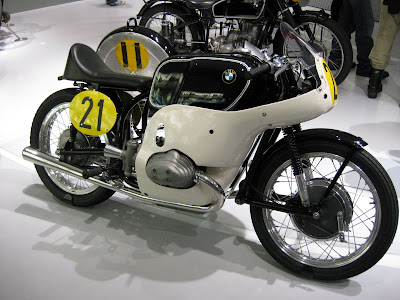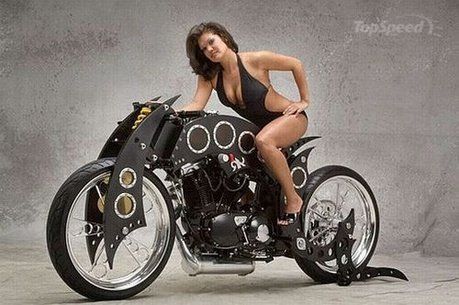 I had the good fortune to visit the new BMW museum last October to see for myself this 'new experience' in museum design and display, which opened only last June (2008). Located near the 1974 Olympic Pavillion (designed by Otto Frei), which looks remarkably fresh, this reconfigured public area of the BMW factory connects a new high-tech showroom via flying bridge to the new museum, attached like a futuristic carbuncle to the original 'bowl' museum, built in 1973 to a design by Viennese architect Karl Schwanzer (who also designed the 'four cylinder' BMW office tower nearby). The concept for the old 'bowl' was an 'enclosed circular continuation of the road', on an upwardly spiraling ramp - an unaknowledged nod to Frank Lloyd Wright's Guggenheim museum built in 1959 (although it came full circle when the Gugg hosted the 'Art of the Motorcycle' exhibit - somebody had been to Munich!). I last visited the BMW factory in 1988 (how time flies...), and have pleasant memories of the display of their racing cars and motorcycles, wired in place on large black faux-blacktop display walls.
I had the good fortune to visit the new BMW museum last October to see for myself this 'new experience' in museum design and display, which opened only last June (2008). Located near the 1974 Olympic Pavillion (designed by Otto Frei), which looks remarkably fresh, this reconfigured public area of the BMW factory connects a new high-tech showroom via flying bridge to the new museum, attached like a futuristic carbuncle to the original 'bowl' museum, built in 1973 to a design by Viennese architect Karl Schwanzer (who also designed the 'four cylinder' BMW office tower nearby). The concept for the old 'bowl' was an 'enclosed circular continuation of the road', on an upwardly spiraling ramp - an unaknowledged nod to Frank Lloyd Wright's Guggenheim museum built in 1959 (although it came full circle when the Gugg hosted the 'Art of the Motorcycle' exhibit - somebody had been to Munich!). I last visited the BMW factory in 1988 (how time flies...), and have pleasant memories of the display of their racing cars and motorcycles, wired in place on large black faux-blacktop display walls. 
The original museum remains in place (see pic from the new showroom above, and the interior below), fairly unchanged, althoug only temporary exhibitions are held there (or not - it was mostly empty), plus exclusive dealer/investor/client/new model unveiling events. Strangely, the interior spiral is printed with an oversize quotation in English. I was not allowed to photograph the many cars 'under wraps' inside the circular halls, but they all looked enormous and clad in polyester (the seamless 'skin', wrinkling at the door joints when passengers exit, is one design concept making the rounds in Munich).

Attached to the silver bowl is the new 'low building', designed by Uwe Bruckner, which also utilizes the concept of the 'road brought inside' (with black tarmac-ish walkways), but does away with the previous circular movement, in favor of a guided pathway through a series of seven concept-boxes on multiple levels. While the old concrete building had a graceful curved interior, the new space is rigidly rectilinear, using acrylic panel walls, illuminated from within. The illusion of movement is created with ceaselessly projected shadow imagery across the glowing white walls. Abstract shapes float ghostly grey in your peripheral vision, as a timeline of motorcycle specters march dutifully across the floor line. A dazzling effect, like visiting a museum in a dream. ICT (Innovative Communication Technologies), designers of the interior spaces, have created the entire interactive experience, with 'talking walls' in multiple languages (depending on where you stand - Deutsche or English) and the world's largest touch-panel display table, where teenagers intuitively grasp the process of exploring the company history.
To say the building is 'wired' is to understate the case; visitors are tracked by infrared beams from a central core which keeps tabs their numbers, migration patterns, and individual locations; activating movies when viewers come within range of an exhibit, triggering audio explanations or sound effects, changing light patterns around the cars and motorcycles. Large display books on tables are 'watched ' from above, and pattern-matching software reads the page while soundwaves of an audio track are bounced off the book surface to the viewer, changing as the pages are turned.
A(nother) new technology is 'panphonic' display audio; by stepping onto an inlay on the floor, a projected audio file can only be heard by a listener in that exact location - your friend nearby can't hear the audio at all. I'd read about this new technology being an unobtrusive targeted advertising media, but hadn't experienced it until now. The total effect is very impressive, and I've included a few videos which give the overall effect.
There's also a groovy kinetic sculpture room where 714 metallic balls (silver of course - I didn't mention that EVERYTHING is silver) are manipulated to create 3-d silhouettes of cars past and present - see the video below.
The new car showroom is a twisted concrete and glass carapace in the post-Bilbao Contemporary Museum style, all compound curves and spiraling glass towers. Inside, an elevated central platform is surrounded by a mezzanine; clever social engineering dictates an oasis of privilege at the heart - the punters gape from across a moat, from the encircling walkway/restaurant/bookstore area. Only purchasers of new BMWs are allowed on this dais, where customers become celebrities on a black-carpet drive, after being hosted around their new cars under the presumably envious gaze of the public. Once inside, the owners drive leisurely off the platform, down a circular ramp, in full view of the assembled throng. Clever.

That's the architecture - and so to the nitty gritty; the motorcycles! I was aghast on entering the museum to find a three-story stack of two-wheeled BMWs, arranged by date behind a glass wall; there's little I find more pointless than looking at motorcycles through glass.

My fears were shortly alleviated, as a small room nearby held a supercharged '39 Rennsport suspended on steel rods, fully accessible, with no alarms or glass to prevent a moment of intimacy with this pinnacle of BMW history. My photos tell the tale - get as close as you like, in any of 3 dimensions, even underneath, to answer any questions about the machine or just take it all in as one could never before.

And new facts emerged - I never knew that these machines used pannier tanks, bolted together.

I had a racing R51ss with period replica Rennsport tank, which was externally identical to this racer - but only in photos; the Works item is far more complex, and larger.

It's possibly a long-range tank for the machine George Meyer rode to victory in the '39 Isle of Man Senior TT (and I believe the museum bought this bike from John Surtees). The plunger rear suspension is damped by an Andre pattern friction damper, attached to the frame and the final drive housing.

Two other supercharged machines can be pored over in other rooms, where, again, the motorcycles are free-standing and completely accessible, almost haphazardly lined up (see photos). A streamlined WR500 record-breaker sits near an R90S production racer, with sidecar GP machines jostling with Paris-Dakar winners. The displays are restrained in the sense that there is no attempt to cram every important or historic machine into the capacious halls.

There are perhaps 40 motorcycles which are readily accessible, and another 40 or so behind glass or suspended above walkways, which may sound paltry, but it gives the visitor the mental space to take in the details of what is present, rather than glazing over at the overkill of a sea of motorbikes.

Of course there are cars, wonderful cars, historic cars, silver cars, even prosaic cars in funny displays which make a nod to period quirks.

An Isetta and a 2002 sit underneath clusters of 60's and 70's color-coded ceiling lamps, while in another room, a display of 60s/70s BMW sedans has a back wall of veneer zebra wood paneling and carpet, evoking a classic German business-office suite of the day; someone at ITC has a sly sense of humor.

My favorite car was the 1938 328 Mille Miglia racer, strangely glassed-off, in contrast to the motorcycles. A moving photo display lines the wall behind, and gives a bit of context, plus the evolution of the car's design.

It was clear from my visit that BMW has poured a tremendous amount of money into their premier showplace, and they've pulled it off; it's a cutting-edge facility with a wow factor which will last many years. The Olympic stadium nearby must have stood as a challenge to the architects - 'make something new, which will last'. I highly recommend a trip if you're anywhere near Munich.










No comments:
Post a Comment